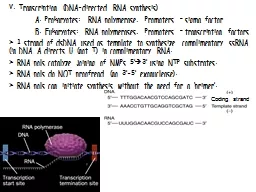

synthesis A Prokaryotes RNA polymerase Promoters sigma factor B Eukaryotes RNA polymerases Promoters transcription factors 1 strand of dsDNA used as template to synthesize complimentary ID: 717257
Download Presentation The PPT/PDF document "V. Transcription (DNA-directed RNA" is the property of its rightful owner. Permission is granted to download and print the materials on this web site for personal, non-commercial use only, and to display it on your personal computer provided you do not modify the materials and that you retain all copyright notices contained in the materials. By downloading content from our website, you accept the terms of this agreement.
Slide1
V. Transcription (DNA-directed RNA synthesis) A. Prokaryotes: RNA polymerase, Promoters – sigma factor B. Eukaryotes: RNA polymerases, Promoters – transcription factors 1 strand of dsDNA used as template to synthesize complimentary ssRNA (in DNA A directs U (not T) in complimentary RNA. RNA pols catalyze joining of NMPs 5’3’ using NTP substrates. RNA pols do NOT proofread (no 3’-5’ exonuclease). RNA pols can initiate synthesis without the need for a ‘primer’.
Coding
strand Slide2
A. ProkaryotesConsensus sequences: sequence of nucleotides found most often in each position Coding strands with promoters for different genes.
All genes have a promoter.
Some promoters recognized better than others
increased rate of initiating transcription.
+1 = site on coding (+) strand of DNA where RNA polymerase begins RNA synthesis
1 RNA
pol
synthesizes all RNAs (except primers in DNA synthesis).
RNA
pol
holoenzyme
:
multiple subunits.
sigma subunit (σ)
= important in initiating transcription; helps RNA
pol bind correct template strand & recognize gene promoters = DNA sequences “upstream” of transcription initiation site. different σ factors recognize different promoters (σ70 = most genes; σ32 = heat shock proteins; σ28 = flagella & chemotaxis genes). 2 DNA sequences (-35 & -10) found in most prokaryotic promoters – “upstream” of transcription start site (+1).Slide3
Promoter
(-35 -10)
Stages = Initiation, Elongation,
Termination
About 10 more nucleotides are slowly polymerized as RNAP tries to ‘clear’ the promoter
σ factor
then leaves RNAP
holoenzyme
“core” RNA
pol
rapidly
moves “downstream”, synthesizing RNA in the 5’
3’ direction.
Initiation = slow:
RNA
pol
(RNAP)
holoenzyme
“slides” along
dsDNA
until it reaches a promoter
recognized by
σ factor ( )
.
RNAP
holoenzyme
unwinds DNA to begin synthesis using one DNA strand (-) as template.
1
st
ribonucleotide
is base paired with the transcription start nucleotide (+1) in template DNA.